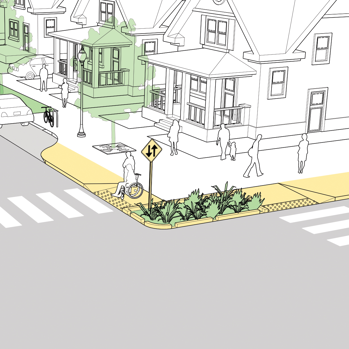- Must be a Residential Street.
- Adequate Traffic Volume – between 1 and 5000 trips per day.
- Speeding – speeds are measured at over 10km/hr over the speed limit. Click to view the Traffic Speed Count Map.
- Pedestrian use – streets must be close to where people walk to or from.
- Support from neighbors – 75% of residents within 75m of the proposed traffic calming must be in favor of the proposal.
- Established Traffic Patterns – Current and future traffic patterns will be considered.
Traffic Calming
What is Traffic Calming?
Traffic calming is the use of physical design measures to restore a road to its intended function. Its key purpose is to improve road safety for motorists, pedestrians, and cyclists by altering traffic speed, volume, and many other parameters. Improper use of Traffic Calming devices can have adverse effects to the community. The Department of Public Works performs traffic studies and uses the Traffic Calming Policy to ensure proper use.
Traffic Calming Policy
The City of Prince Albert Traffic Calming Policy was issued in 2016 to provide a standard procedure for implementation of Traffic Calming measures.
Requirements for Traffic Calming Device
How to request a Traffic Calming Device
If you feel that your street meets the requirements, call 306-953-4900 and ask to speak with the Transportation and Traffic Manager. The Transportation and Traffic Manager will recommend that you start collecting signatures from your neighbors to demonstrate neighborhood support. Additionally, the following steps are required:
- Speeds may be measured by the Public Works department.
- Traffic Calming Plans may be made if traffic volumes and speeds are measured high.
- Feedback may be collected from residents, emergency services etc….
- Approval may be recommended to City Council.
- Implementation may be completed, if approved by City Council.
This process can take an average of a year to obtain the proper speed counts, receive approvals and make necessary budgets.
Common Traffic Calming Measures
- Speed Humps – Used to slow vehicles to the roads intended speed. Improper use of this device can lead to vehicles rerouting to residential streets.
- Raised Crosswalks – Generally used near school zones to slow traffic and enhance pedestrian crossing safety.
- Curb Extensions – This treatment is used at intersections to narrow lane width and reduce pedestrian crossing distance. This slows traffic speeds to reduce collision and increases pedestrian safety.

- On Street Parking – Vehicles parked alongside the street requires drivers to pay more attention to how they are driving. This slows vehicle speeds and provides an extra safety buffer for pedestrians using the sidewalk nearby.
- Lane Width – Reducing lane widths of a street requires drivers to slow down and pay more attention. This is why residential streets have narrower lanes than highways.
- Speed Monitoring Radars – These radars are used throughout the City to alert drivers of the speed they are moving at. This allows drivers to reduce their speed if they notice they are above the limit.
Traffic Calming Objective
- Reducing collision frequency and severity.
- Restoring streets to their intended speed and volume.
- Enhancing the street environment.
- Reducing vehicle rerouting to residential streets.
- Improving access for all modes of transportation.
- Reducing reliance on Police enforcement.
Updated December 16, 2021
Contact Us
City of Prince Albert
1084 Central Avenue
Prince Albert, SK S6V 7P3
Phone: 306-953-4884
After Hours Emergency: 306-953-4348
Email Us




